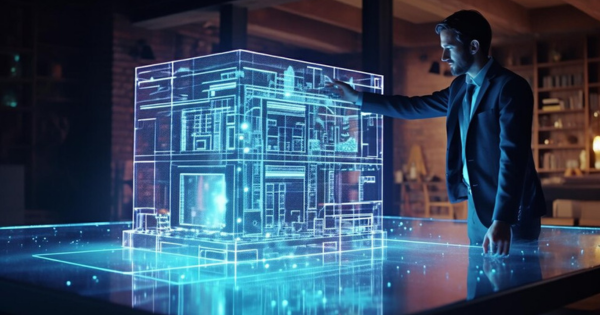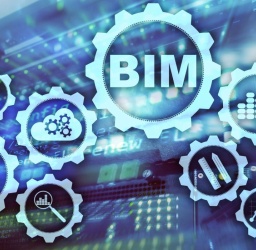The Future of Construction: Key BIM Trends Shaping 2025

Building Information Modeling (BIM) has emerged as a vital force in revolutionizing the construction industry, creating a shift in how projects are designed, managed, and delivered. With BIM technology, Architecture, Engineering, and Construction (AEC) professionals gain a powerful tool for improving project accuracy, efficiency, and collaboration across every stage of the building lifecycle. As we approach 2024, several groundbreaking trends in BIM promise to reshape the construction landscape, setting new standards for innovation and project success.
Integration of AR and VR in Construction
The integration of Augmented Reality (AR) and Virtual Reality (VR) with BIM modeling provides AEC professionals with immersive experiences that revolutionize project visualization. VR offers detailed 3D visualizations, allowing stakeholders to explore and assess spaces virtually before construction even begins. AR, on the other hand, enables real-time overlay of digital data on the physical world, assisting on-site workers in understanding complex elements of the design directly in their work environment. This seamless merging of physical and digital realms reduces errors, enhances stakeholder communication, and increases overall project quality by offering virtual walkthroughs and previews, making complex projects more accessible and understandable.
EXPLORE ALL TRAINING OPPORTUNITIES BY UDC TRAINING CENTER
Artificial Intelligence and Generative Design: The New Frontier
As Artificial Intelligence (AI) grows more sophisticated, its applications within BIM modeling services have expanded, particularly through generative design. Generative design uses AI algorithms to produce numerous design variations based on set parameters like budget, materials, and performance requirements. This innovation allows designers and engineers to test multiple configurations quickly, optimizing for cost and efficiency while maintaining structural integrity. AI’s role doesn’t end with design; it’s also instrumental in project scheduling, cost estimation, and risk assessment, ensuring that projects are not only creative but also feasible and safe.
Digital Twin Technology: Enhancing Lifecycle Management
Digital twin technology, which creates a digital representation of a physical structure, is transforming lifecycle management in construction. This technology enables real-time monitoring of building performance, allowing project managers to make data-driven decisions throughout a structure’s lifecycle—from design and construction to maintenance and operation. The technology provides a digital mirror for complex projects, such as shopping centers or stadiums, where monitoring high-traffic sites is crucial. With digital twins, project stakeholders can track maintenance needs, optimize resource allocation, and predict potential issues before they escalate, ultimately extending the lifespan of buildings and improving resource efficiency.
Modular Construction and Prefabrication: Building Efficiency Off-Site
Modular construction and prefabrication have become significant trends as the construction industry seeks methods to reduce costs, accelerate timelines, and improve safety standards. In modular construction, building components are prefabricated off-site in controlled environments, ensuring higher quality and lower waste. These modules are then transported and assembled on-site, reducing the need for extensive on-site labor and speeding up the construction process. The precision of BIM modeling supports prefabrication by ensuring that every module fits seamlessly into the overall structure, making it an ideal solution for eco-friendly, scalable, and flexible construction projects.
EXPLORE ALL TRAINING OPPORTUNITIES BY UDC TRAINING CENTER
IoT and Smart Buildings: Connected Spaces for Enhanced Functionality
The Internet of Things (IoT) has introduced a new level of intelligence to buildings, making “smart” buildings possible. IoT devices can be embedded in various building components—like HVAC systems, lighting, and security—to collect and communicate data in real-time. Through BIM, this data can be seamlessly integrated into the project design, offering enhanced monitoring and maintenance capabilities. This real-time data enables predictive maintenance, energy management, and enhanced user comfort, all of which contribute to the operational efficiency and sustainability of the building. As smart buildings grow in popularity, BIM and IoT integration will be essential for creating responsive, user-centric spaces.
Robotics in Construction: Automating the Future
The advent of robotics in construction is transforming how projects are executed, bringing automation to repetitive and labor-intensive tasks. Robots can now perform tasks like bricklaying, concrete pouring, and material handling with precision and consistency, reducing the need for human labor and enhancing safety on-site. Robotics also allow for faster project timelines, as machines can work continuously without fatigue, resulting in a more streamlined workflow. Combined with BIM, robotics can follow precise design plans, ensuring accuracy and minimizing errors, which enhances overall project productivity and reduces costs.
3D Printing: Revolutionizing Material Use
3D printing is another exciting trend reshaping construction. This technology allows the creation of complex structures directly from digital models, minimizing material waste and reducing construction time. With 3D printing, project elements can be prefabricated and assembled on-site, allowing for faster builds and customized designs. BIM plays a pivotal role in 3D printing by providing the accurate models needed for production, ensuring that all parts fit together perfectly.
Blockchain: Securing Data in BIM Models
As BIM usage grows, so does the need for robust data security. Blockchain technology offers a secure and transparent way to manage and store BIM data, providing an immutable record of all project-related information. Blockchain’s decentralized nature prevents unauthorized access or tampering, ensuring data integrity and enhancing trust among stakeholders. This level of security is particularly valuable for large projects involving multiple parties, where secure and transparent data exchange is essential for effective collaboration.
EXPLORE ALL TRAINING OPPORTUNITIES BY UDC TRAINING CENTER
Cloud-Based Collaboration: Real-Time Project Access
Cloud-based BIM platforms enable seamless collaboration, allowing project data to be accessed and modified in real-time by all stakeholders, regardless of location. Cloud platforms streamline workflows, ensuring that everyone involved in the project is up-to-date with the latest information, reducing the risk of errors and miscommunication. The ability to access data on-demand fosters greater teamwork and enables quicker decision-making, which is especially important for large, multi-team projects.
Prioritizing Sustainability in Design
Sustainable construction practices are at the forefront of AEC priorities, and BIM has become an invaluable tool in supporting this shift. By incorporating energy modeling, CO2 calculations, and simulations of different energy-efficient systems, BIM allows designers to evaluate and choose sustainable options early in the design process. This proactive approach to sustainability reduces environmental impact and helps meet increasingly stringent green building standards.
Conclusion: Embracing BIM for a Sustainable Future
The future of construction is firmly intertwined with the technological advances in BIM. From augmented reality and digital twins to 3D printing and sustainability-focused design, BIM is pushing the boundaries of what’s possible in construction. By adopting these trends, AEC professionals can enhance efficiency, safety, and sustainability, paving the way for a connected and intelligent built environment. In 2024, embracing BIM will not only redefine project outcomes but will also position firms for success in an industry increasingly driven by innovation.
Share:
Διαβάστε Επίσης
Από τις παραδοσιακές 2D απεικονίσεις έχουμε πλέον περάσει σε έξυπνα τρισδιάστατα μοντέλα
Το BIM, ως πλατφόρμα ψηφιακής αναπαράστασης και διαχείρισης των πληροφοριών ενός κτιρίου
 Ελληνικά
Ελληνικά  English
English


